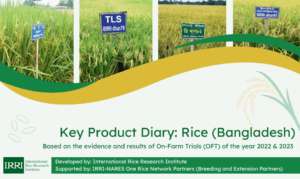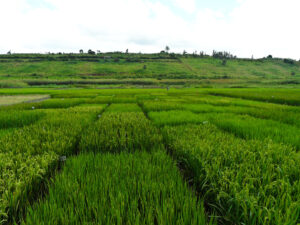Easy-to-use technologies are reducing farmers’ fertilizer wastage, production cost, and impact on the environment.

Plant nutrients play an important role in crop production and the realization of food security. The proper amount of fertilizer, the correct nutrients in the right proportion, and the application of fertilizer at the right time and through appropriate methods help farming communities attain higher yields and profitability. Balanced fertilization also helps maintain soil health, which leads to environmentally sustainable farming.
In South Asia, however, most farmers are often unaware of the specific role and contribution of each plant nutrient. Farmers’ fertilizer decision-making processes are commonly limited and usually based on perceptions that rarely follow the concept of balanced nutrition.
The hunger for nitrogen
Grain production is proportionate to fertilizer usage. Among the three major fertilizers—nitrogen, phosphorus, and potassium—the global use of nitrogenous fertilizers (urea) is the biggest. The world nitrogen fertilizer demand increased from more than 111.4 million tons in 2013 to 113.1 million tons in 2014 and it is expected to be around 119.4 million tons in 2018 (World fertilizer trends and outlook to 2018, FAO).
India is one of the world’s largest consumers of urea. The consumption of urea in the country has increased manyfold after the Green Revolution. This is mainly due to the lack of soil testing facilities for a large number of marginal farmers who are mostly unaware of modern tools and techniques. Often, the farmers’ decision to apply fertilizer is resource-driven rather than science-driven as they have no tools to measure the available nutrients present in the soil. They often have no idea of the soil’s inherent capacity to supply nutrients.
Maximum effort, minimum impact
These practices not only result in low crop productivity but also adversely affect the environment. Although India produces 10% of world fertilizer, it relies on expensive imported urea to fulfill the local nitrogen consumption (FAOSTAT 2013). The cost of importing nitrogenous fertilizers and the government subsidy for urea increased tremendously from year 2005-06 to 2014-15 but did not result in any significant increase in cereal production, according to government and FAO data.
The 4Rs of nutrient management
In spite of the high cost and unwanted environmental impact of fertilizer, we cannot overcome the challenges of increasing global population and decreasing arable land without its use. Hence, the importance of knowledge on the efficient use of fertilizer is essential for economic reasons as well as for limiting the effect of its excess usage on the environment.
Precision nutrient management combined with soil health improvement will play a crucial role in crop production. This demands a better nutrient management recommendation guideline for farmers that is scientifically robust and user-friendly to help them adhere to the 4Rs: right amount, right source, right application method, and right application timing.

Farmer-friendly tools
Some farmers now have access to tools such as Crop Manager, Green Seeker, and the leaf color chart for site-specific fertilizer application. The major benefits of using nutrient management tools include smart fertilizer usage that cuts down wastage and the cost of production and, hence, brings about an increase in income, higher crop productivity, and lower greenhouse gas emissions from rice production.
Crop Manager. The International Rice Research Institute (IRRI), through the Cereal Systems Initiative for South Asia project, and collaborating government agencies have developed Crop Manager, a web- and Android-based decision-making tool that provides location-specific fertilizer recommendations for farmers growing rice-wheat and maize in Bihar and eastern Uttar Pradesh.
This easy-to-use app, designed for small-scale farmers and extension workers, can rapidly provide nutrient recommendations for individual farmers’ fields with or without soil testing data. The farmers provide information about their field and crop management practices such as planting method, rice variety, typical yields, choice of fertilizer, method of harvesting, etc. Based on these inputs, this tool recommends how much nitrogen, phosphorus, and potassium to apply and the critical growth stages of the plant when these should be added to obtain higher yield and profit. Crop Manager aims to increase farmers’ income by USD 100 per hectare per crop.
Green Seeker. This tool can be used to readily derive the nitrogen requirement of a standing crop through a smart mobile application. This handy instrument determines the right amount, the right place, and the right time to apply nitrogen, thereby optimizing fertilizer input and yield.
Leaf color chart. Primarily developed for rice, this chart helps farmers rapidly assess leaf nitrogen status at crop growth stages as a basis for the amount of nitrogen to be applied. This tool has four green strips with colors ranging from yellow green to dark green. It determines the greenness of the rice leaf, which indicates its nitrogen content.
Soil health cards. In 2015, the Government of India launched the soil health cards to improve the soil health of individual farmers’ fields. Under the scheme, soil samples from farmers’ fields are analyzed in various soil testing laboratories across the nation for water content and water retention capacity, presence of macro- and micronutrients, pH and salinity levels, and clay content. The results are handed over to the farmers in the form of a soil health card to serve as a guide for applying fertilizer for various crops._
_______________________
Ms. Kumari is an extension agronomist at IRRI-India.







Hello
I am from Punjab, India, working as Agricultural Development Officer. Here the productivity of rice crop is very good, but still, have many issues like the excess of fertilizer usage, the excess of pesticides usage. Depletion of groundwater level and quality is yet another problem. Do you offer any online course so that I can enhance my skills in rice crop production.
Regard!